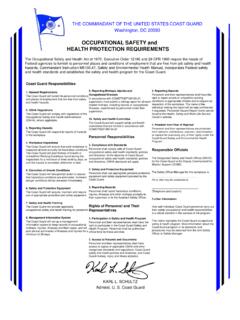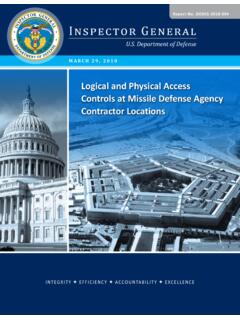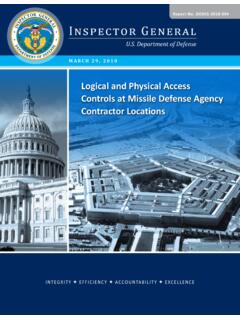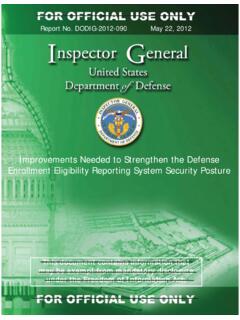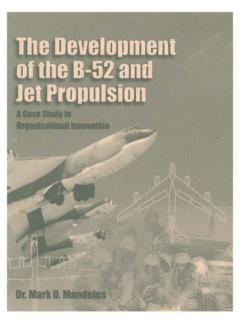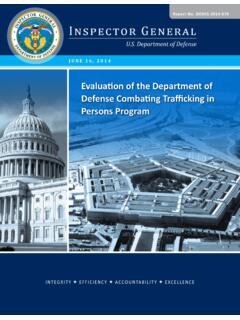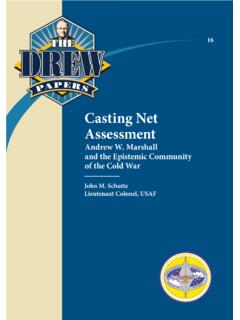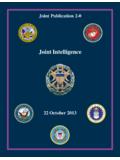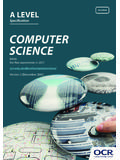Transcription of CHALLENGES TO SECURITY IN SPACE - U.S. Department of …
1 DEFENSE intelligence AGENCYC ommitted to Excellence in Defense of the NationCHALLENGES TO SECURITY IN SPACEDIA_F_01403_AThis report is available online at For media and public inquiries about this report, contact For more information about the Defense intelligence Agency, visit DIA's website at cutoff date, January image source: ShutterstockDEFENSE intelligence AGENCYIIICHALLENGES TO SECURITY IN SPACEEXECUTIVE SUMMARYS pace-based capabilities provide integral support to military, commercial, and civilian applications.
2 Longstanding technological and cost barriers to SPACE are falling, enabling more countries and commercial firms to participate in satellite construction, SPACE launch, SPACE exploration, and human spaceflight. Although these advancements are creating new opportunities, new risks for SPACE -enabled services have emerged. Having seen the benefits of SPACE -enabled operations, some foreign governments are developing capabilities that threaten others ability to use SPACE . China and Russia, in particular, have taken steps to challenge the United States: Chinese and Russian military doctrines indicate that they view SPACE as important to modern warfare and view counterspace capabilities as a means to reduce and allied military effectiveness.
3 Both reorganized their militaries in 2015, emphasizing the importance of SPACE operations. Both have developed robust and capable SPACE services, including SPACE -based intelligence , surveillance, and reconnaissance. Moreover, they are making improvements to existing systems, including SPACE launch vehicles and satellite navigation constellations. These capabilities provide their militaries with the ability to command and control their forces worldwide and also with enhanced situational awareness, enabling them to monitor, track, and target and allied forces.
4 Chinese and Russian SPACE surveillance networks are capable of searching, tracking, and characterizing satellites in all earth orbits. This capability supports both SPACE operations and counterspace systems. Both states are developing jamming and cyberspace capabilities, directed energy weapons, on-orbit capabilities, and ground-based antisatellite missiles that can achieve a range of reversible to nonreversible and North Korea also pose a challenge to militaries using SPACE -enabled services, as each has demonstrated jamming capabilities.
5 Iran and North Korea maintain independent SPACE launch capabilities, which can serve as avenues for testing ballistic missile advantage the United States holds in SPACE and its perceived dependence on it will drive actors to improve their abilities to access and operate in and through SPACE . These improvements can pose a threat to SPACE -based services across the military, commercial, and civil SPACE LEFT BLANKDEFENSE intelligence AGENCYVCHALLENGES TO SECURITY IN SPACEINTENTIONALLY LEFT BLANKI ntroduction.
6 7 Key SPACE Concepts ..8 Key Counterspace Concepts ..9 SPACE -based Services ..11 Orbit Types and Uses .. 12 China ..13 Strategy, Doctrine, and Intent .. 14 Key SPACE and Counterspace Organizations .. 14 SPACE and Counterspace Capabilities .. 16 SPACE Launch Capabilities .. 16 Human Spaceflight and SPACE Exploration ..18 ISR, Navigation, and Communications Capabilities .. 18 Counterspace Capabilities ..20 Russia .. 23 Strategy, Doctrine, and Intent .. 23 Key SPACE and Counterspace Organizations.
7 24 SPACE and Counterspace Capabilities .. 25 SPACE Launch Capabilities ..25 Human Spaceflight and SPACE Exploration ..26 ISR, Navigation, and Communications Capabilities ..26 Counterspace Capabilities ..28 Other SPACE CHALLENGES ..31 Iran .. 31 North Korea ..32 Outlook ..33 Appendix A: Implications of Debris and Orbital Collisions .. 35 Appendix B: Counterspace Threats .. 36 Appendix C: Glossary of Acronyms .. 37 CONTENTSINTENTIONALLY LEFT BLANKDEFENSE intelligence AGENCY7 CHALLENGES TO SECURITY IN SPACEINTENTIONALLY LEFT BLANKINTRODUCTIONA lthough the United States and the former Soviet Union dominated early SPACE activities, SPACE capabilities have proliferated over the past six decades as technological and cost barriers have fallen.
8 These capabilities provide important support to many of society s daily activities, including communications, navigation, financial transactions, and weather monitoring. As of 2018, over 1,800 active satellites are on orbit, which are owned and operated by over 50 countries and multinational Nine countries and one international organization can independently launch spacecraft: China, India, Iran, Israel, Japan, Russia, North Korea, South Korea, the United States, and the European SPACE Agency (from French Guiana).
9 2 SPACE has also become more commercialized. The commercial SPACE sector is involved in SPACE launch, communications, SPACE situational awareness, remote sensing, and even human spaceflight. These firms not only supply products to governments, but they also compete number of objects on orbit both active satellites and orbital debris will continue to increase rapidly with the wider availability of lower cost, small satellites and with the prospect of large constellations consisting of thousands of satellites.
10 The challenge of SPACE congestion will grow, and actors will need better capabilities to track and identify objects and prevent collisions in ,5 SPACE capabilities have become central to many military operations, including missile warning, geolocation and navigation, target identification, and tracking of adversary activities. The military and intelligence collection capabilities that government and commercial remote sensing satellites provide is reducing the ability of all countries to remain undetected while performing sensitive testing and evaluation activities or military exercises and ,7 Some actors are seeking ways to deny the effectiveness of the United States, having witnessed more than 25 years of military successes enabled by SPACE China and Russia, in particular.
